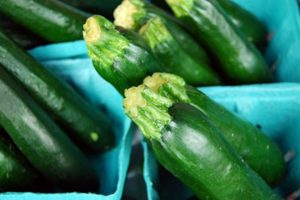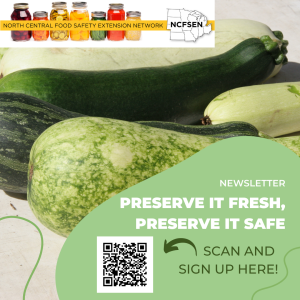 Recommendations for canning summer squashes, including zucchini, that you may have seen in past United States Department of Agriculture (USDA) bulletins have been withdrawn due to uncertainty about the determination of processing times. Squashes are low-acid vegetables and require pressure canning for a specific period of time that will destroy the bacteria that causes botulism. Documentation for the previous processing times cannot be found and reports that are currently available do not support the old process. Slices or cubes of cooked summer squash will get quite soft and pack tightly into the jars. The amount of squash filled into a jar will affect the heating pattern in that jar. For more information, please see National Center for Home Food Preservation – Frequently Asked Canning Questions.
Recommendations for canning summer squashes, including zucchini, that you may have seen in past United States Department of Agriculture (USDA) bulletins have been withdrawn due to uncertainty about the determination of processing times. Squashes are low-acid vegetables and require pressure canning for a specific period of time that will destroy the bacteria that causes botulism. Documentation for the previous processing times cannot be found and reports that are currently available do not support the old process. Slices or cubes of cooked summer squash will get quite soft and pack tightly into the jars. The amount of squash filled into a jar will affect the heating pattern in that jar. For more information, please see National Center for Home Food Preservation – Frequently Asked Canning Questions.
Freezing Zucchini
Freezing Zucchini is very simple. The technique you choose will depend upon how you will use it. To freeze grated zucchini for baking, the National Center for Home Food Preservation recommends:
- Choose young tender zucchini.
- Rinse with running water and trim ends. Scrub with a vegetable brush if needed. Grate squash.
- Steam blanch (directions below) in small quantities for 1 to 2 minutes until translucent.
- Pack in measured amounts into containers or freezer bags, leaving ½-inch headspace.
- Cool by placing the containers or bags in cold water.
- Seal and freeze. If watery when thawed, discard the liquid before using the zucchini.
To steam blanch: Use a pot with a tight lid and a basket that holds the food at least three inches above the bottom of the pot. Put an inch or two of water in the pot and bring the water to a boil. Put the vegetables in the basket in a single layer so that steam reaches all parts quickly. Cover the pot and keep heat high. Cover with lid and start counting steaming time.
To learn how to freeze sliced zucchini click here.
Originally published by the University of Missouri Extension:
Preserve It Fresh, Preserve It Safe; Volume 8, Issue 4; July/August 2022





